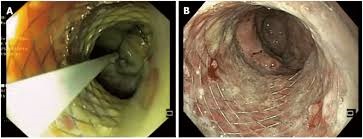
Endoscopic Necrosectomy
Endoscopic necrosectomy is nearly always performed in patients who have suffered an episode of clinically severe pancreatitis, as this group of patients has underlying pancreatic necrosis. Following the onset of severe pancreatitis, endoscopic necrosectomy cannot generally be performed earlier than 2–3 weeks later, and in most cases, we wait 4 weeks or more, as the initial attack of pancreatitis is managed medically. This later time frame is when patients develop a necrotic collection composed of dead pancreas tissue and fluid from their episode of pancreatitis, which appears radiographically as a defined collection on computed tomography (CT).
The necrotic collection can then be accessed through the stomach or duodenum, depending upon the individual patient. The decision to intervene is based not only upon CT imaging results, but also on clinical symptoms, including ongoing severe abdominal pain, persistent symptoms of pancreatitis, pancreatic ascites, and infection. Thus, the use of endoscopic necrosectomy is determined by both the patient’s symptoms and the imaging results; if the patient has minimal symptoms or is doing well, for example, we would likely wait prior to recommending an intervention. In addition, it is very important to stress that necrotic pancreatic collections are often confused radiographically with and mislabeled as pancreatic pseudocysts.
Pseudocysts contain only liquid material, and if a pseudocyst drainage procedure is undertaken in a patient with a necrotic pancreatic collection, inadequate removal of solid material and subsequent infection will occur.


